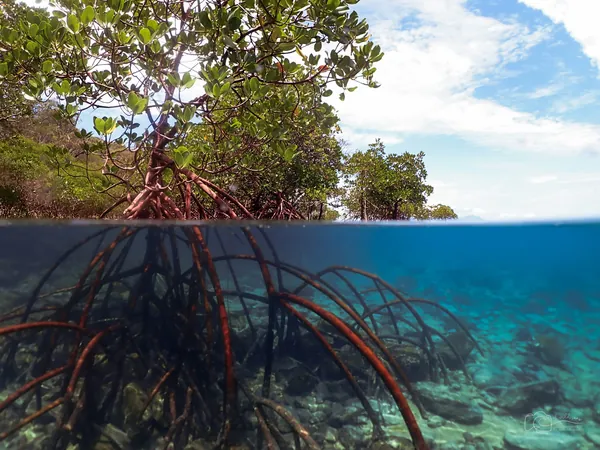
Alarming Decline of Mangrove Forests in China's Pearl Bay: A Threat to Global Carbon Storage!
2024-11-04
Author: John Tan
The Role of Mangrove Forests in Carbon Sequestration
The fight against climate change heavily relies on carbon sinks—natural systems that absorb atmospheric carbon dioxide. Among these vital ecosystems, mangrove forests play a crucial role in coastal areas, particularly in tropical and subtropical regions. These wetland plant communities are paramount for storing significant amounts of organic carbon in both the oceans and the soil.
Threats to Mangrove Ecosystems
However, the ability of these mighty mangroves to sequester carbon is under siege. The threats are twofold: natural factors such as erosion, land subsidence, and rising sea levels, compounded by anthropogenic impacts exacerbated by climate change, including rising temperatures that lead to increased water vapor deficits and salinity levels.
Research Findings on Pearl Bay's Mangroves
A groundbreaking study published in Frontiers in Marine Science explores the alarming degradation of the mangrove ecosystem in Pearl Bay, China, a vital area for coastal carbon storage. Researchers Chuanyi Guo and Dr. Loh Pei Sun from Zhejiang University, alongside international experts, rigorously examined this critical habitat to assess the ongoing challenges faced by these forests.
Mangrove Species and Carbon Levels
The mangroves in Pearl Bay, consisting of species like Aegiceras corniculatum, Bruguiera gymnorhiza, Avicennia marina, and Kandelia obovata, have an average age of 50 years. The upper sediment layers revealed a concerning statistic: approximately 144.5 Mg of organic carbon per hectare—significantly lower than the national average for China’s mangrove forests, which is already only about half of the global average.
Sediment Analysis and Ecosystem Health
Analyzing sediment cores dated between 1963 and 2020, the researchers evaluated changes in sediment composition, carbon storage patterns, and overall ecosystem health. Here are some of their alarming findings:
Key Findings
1. There was a drastic reduction in the mean sedimentation rate, plummeting from about 80 mm per year between 1977 and 1980 to just 17 mm per year from 1980 to 2021. 2. The composition of the sediment has dramatically shifted, with the fine sediment fractions that store organic carbon declining as coarser sand has increased—now comprising approximately 50% sand, 36% silt, and 12% clay since 2001. 3. The essential ratio of total organic carbon to total nitrogen has significantly decreased from 25 to 15 throughout the study period, highlighting a troubling decline in soil health. 4. Moreover, stable carbon isotopes rose by approximately 0.85‰ along both sediment cores, an indicator of changing ecological dynamics. 5. A noteworthy decrease in organic matter derived from mangroves was observed relative to other sources, with mangrove contributions falling from 65% to 57% post-2001. 6. The lignin content, crucial as a component of woody biomass rich in carbon, showed a serious decline over the same timeframe.
Causes of Degradation
Crucially, this loss of organic matter and reduction of lignin since 2001 is attributed to heightened tidal action due to rising sea levels, combined with detrimental human activities such as wastewater discharge and the conversion of mangrove areas into shrimp farms, particularly by the fishing industry. The data indicate not only reduced tidal ranges but also a worrying slowdown in sedimentation rates, both of which further aggravate organic matter depletion.
Global Implications and Conservation Needs
Even though mangrove forests cover merely 0.1% of the Earth’s land area, the implications of this research are profound. The sustainability of these ecosystems is paramount to preventing the loss of essential organic matter and maintaining carbon stocks in the soils. Without intervention, existing carbon reserves could be released back into the atmosphere, transforming these mangroves from invaluable carbon sinks into carbon sources.
Call to Action for Conservation
Efforts to conserve mangrove forests are critical, not just for preserving biodiversity and natural wildlife habitats but also for their essential function in mitigating climate change effects globally. Researchers highlight the urgent need for effective management practices that can safeguard these vital ecosystems, ensuring they continue to perform their crucial role in carbon storage for generations to come. This alarming decline is a wake-up call for environmentalists, policymakers, and the global community!

 Brasil (PT)
Brasil (PT)
 Canada (EN)
Canada (EN)
 Chile (ES)
Chile (ES)
 España (ES)
España (ES)
 France (FR)
France (FR)
 Hong Kong (EN)
Hong Kong (EN)
 Italia (IT)
Italia (IT)
 日本 (JA)
日本 (JA)
 Magyarország (HU)
Magyarország (HU)
 Norge (NO)
Norge (NO)
 Polska (PL)
Polska (PL)
 Schweiz (DE)
Schweiz (DE)
 Singapore (EN)
Singapore (EN)
 Sverige (SV)
Sverige (SV)
 Suomi (FI)
Suomi (FI)
 Türkiye (TR)
Türkiye (TR)